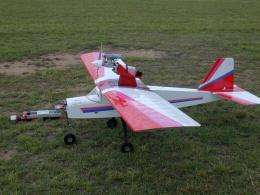Aircraft that can see for themselves (w/ Video)

(PhysOrg.com) -- Australian researchers have made two important advances in the development of unmanned aircraft capable of seeing for themselves as they fly fast and low over dangerous terrain.
A team from the The Vision Centre and Queensland Brain Institute has developed highly effective new visual systems inspired by honey bees and how they navigate successfully around the landscape, despite their tiny brains.
The two innovations, one of which provides stereo vision to enable aircraft to see their way around obstacles in very low-level flight, and the other which controls the aircraft’s attitude by watching the horizon, offer light, low-cost, highly-efficient technologies for use in unmanned aircraft (UAVs).
Both will be unveiled for the first time at the International Conference on Intelligent Robots and Systems, in St Louis, USA from October 11-15.
Unmanned aircraft today have rapidly expanding roles ranging from mineral exploration, mapping, environmental monitoring and coastal surveillance to military applications from scouting and intelligence gathering to interception. In future they are expected to play an important role in the exploration of Mars.
Richard Moore and his colleagues at The University of Queensland node of the ARC Vision Centre, based at the Queensland Brain Institute, have developed a stereo system employing two cameras and two sophisticated, highly curved mirrors, for observing the terrain as it flows beneath the aircraft. The cameras feed back information on height and distance to the terrain and its obstacles in a steady flow.
“You know how things that are close seem to speed by, whereas things farther away seem to travel more slowly,” Richard said.
"Our design eliminates that distortion, enabling us to use the flow of optical data from all parts of the landscape in view to navigate the aircraft, even if it is moving very fast.”
Engineer Saul Thurrowgood and his colleagues have devised a new way to keep aircraft "upright", or to detect their attitude, simply by visual reference to the horizon.
“Aircraft have long used gyroscopes to monitor their attitude, but inertial systems are subject to drift over long times," he said.
"They also don’t like massive acceleration or high levels of vibration. Our visual system is proof against all these things.”
The system compares the blue colour of the sky with the red-green colours of the ground to detect whether the aircraft is pitching up or down, or rolling from side to side.
“It provides an absolute reference to where you are, unlike inertial guidance which infers it from the Earth’s gravity,” he said.
“Trials show our method performs well in varied conditions of cloud, sun, altitude and different imaging systems, and is resistant to false horizon edges such as large trees, sky reflection from lakes or glare when the sun is in full view."
The technology is designed to be incorporated into an existing aircraft visual system, or to be stand-alone.
Both systems have been developed to operate in daylight, but the researchers say they are capable of being adapted to infra-red and other forms of visual sensing for operation in the dark or low light. They are both lighter, cheaper and more efficient than radar-based sensing systems.
The research team has collaborated with the US space agency NASA on the use of visual navigation for the tiny unmanned aircraft which are envisioned as the main explorers and mappers of the planet Mars, once exploration begins in earnest.
Provided by University of Queensland (news : web)
















